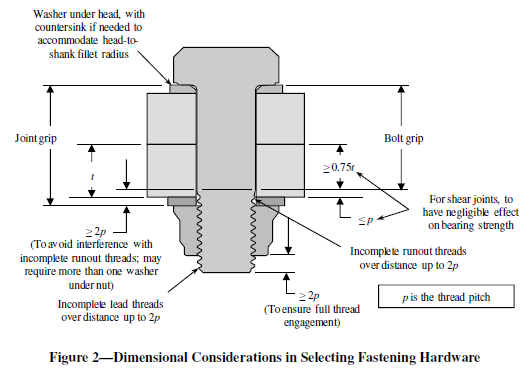Whoooaaaa tigers...
Conrad1 made an initial statement that I’m extremely confused and uncomfortable about, thus...
”I usually choose the combination NAS67xx (bolt) and MS17825 (nut) – and the cotter pin of course. During the stress calculations of the bolted connections,...”
What has me really bothered/confused... is ”NAS67xx (bolt) and MS17825 (nut) – and the cotter pin..”.... why??? This almost sounds like standard practice...
Analysis would NORMALLY lead me to conclude that this is STRICTLY a non-structural mechanical installation, ONLY... since this combination [long-thread bolt, castellated nut, cotter-pin] would be a non-credible departure from established standard structural Assy practices... where a shear-tension rated short thread bolt with a low-height shear-tension self-locking-nut ONLY would be used in typical fastener patterns.
With the one exception of a pin-lug joint where the single bolt connects lug-A to Lug-B and pre-load torque-tension is deliberately held ‘low’ so there is no significant tension loading on the bolt and/or thru the lug stack-up... which is loaded in high/critical shear.... and where lug-bending pre-load would be very bad... and where minute movement in the joint could cause the loosening/loss of a self-locking nut.
Then I got knocked back when You wanted to match a higher-tension/high-temperature rated BARE A286 castellated nut... typically installed in a turbine engine case application... onto a cadmium plated A286 airframe bolt.
CAUTION!
MS9358 [AS9358 procurement spec] is bare A286. A bare A286 nut installed-onto a cadmium plated A286 bolt... similar HT and high-quality/precision threads... torqued together to a high preload limit without any antiseize compound... is almost a guaranteed galling situation [I know all-too-well from experience]. Similar high strength A286 airframe nuts intended for installation on A286 cadmium plated or aluminum coated bolts will either be passivated with a 100% solid film lubricant coating [preferred] or 100% cadmium plating [usually obsolete]... which should be a suitable ant-galling combination... and eliminate the need for high temp antiseize lubricant.
I guess the follow-up question I have is: exactly what kind of installation are You designing/analyzing and why is a high torque-tension preload required and which also needs dual thread locking capability [self-locking + cotter-pin]????
NOTE.
Usually I state the installation process for a castellated nut, thus for [hypothetical mechanical installation]...
Torque nut to 140-to-150-in#, then back-off nut to ‘finger-tight/loose’. Immediately torque-nut to 100-in#... then torque-turn nut [tighter], MINIMUM required to align bolt-thread pin-hole with next nut castellation slot-pair. Install cotter-pin per NASM33540. Ensure cotter pin is fully engaged in castellation slots. May adjust cotter-pin location by adding disassembling/reassembling with [a] [specified] added washer(s) or with a single thinner washer.
NOTE.
Torque-turning a bolt head for this type installation is more complex
FYI NOTE [at risk of sounding like an irritating ‘know-it-all’].
NAS6703-to-6720 [A286] bolt is actually an evolution of the NAS1303-to-1320 [nom Dia] + NAS2903-to-2920 [1/64-OS] + NAS3003-to-3020 [2/64-OS] bolts, as follows...
NAS1303-to-1320 + NAS2903-to-2920 + NAS3003-to-3020 evolved directly to the NAS6603-to-6620 [Cd plated steel... Nom, X, Y Dias]... which also included the A286 version NAS6703-to-6720 [bare, Cd plated, aluminum coated... Nom, X, Y Dias]... and the titanium 6Al-4V NAS6803-to-NAS6820** version [bare or aluminum coated... Nom, X, Y Dias].
**Titanium bolt procurement NEVER allowed diameters up-to 20/16”... only 16/16” [1.000-inch]
FYI NOTE [at risk of sounding like an irritating ‘know-it-all’].
A long thread bolt can always accommodate a wide variety of nuts depths [heights if You prefer], from very shallow [light shear] to very deep [high tension] designated nuts. Hence an LT thread bolt can be used in pure shear or shear-tension applications, simply based on the installed NUT.
Conversely, a short threaded bolt## is usually limited to a very specific range of low depth [height] low/medium tensile strength nuts: usually allowing medium/high-shear with a relatively low [not negligible] tension rating
## NAS6203-to-6220 [steel], NAS6303-to-6320 [A286] and NAS6403-to-6420 [titanium] bolts are short thread versions of the long-thread bolts mentioned above [and also include the Nom, 1/64-OS and the 2/64-OS sizes]. These evolved from [steel] NAS1303-to-1320 [nom Dia] + NAS2903-to-2920 [1/64-OS] + NAS3003-to-3020 [2/64-OS] bolts, as follows...
FYI NOTE [at risk of sounding like an irritating ‘know-it-all’].
The reason for grouping steel, A286 and titanium parts together??? Steel is generally best defined as 'rusted = busted = corroded aluminum or steel or magnesium'.
A286 and Titanium have equivalent strength and fracture performance [with certain exceptions/limitations]... with a low/non-existent potential for [themselves] corroding in-service and affecting the structure. HOWEVER, this all presumes suitable protection for the base alloy structural elements from the peculiarities/dissimilarities of these alloys.
I hope this makes sense... barely makes sense to me... Gotta get back to work.
Regards, Wil Taylor
o Trust - But Verify!
o We believe to be true what we prefer to be true. [Unknown]
o For those who believe, no proof is required; for those who cannot believe, no proof is possible. [variation,Stuart Chase]
o Unfortunately, in science what You 'believe' is irrelevant. ["Orion", Homebuiltairplanes.com forum]

